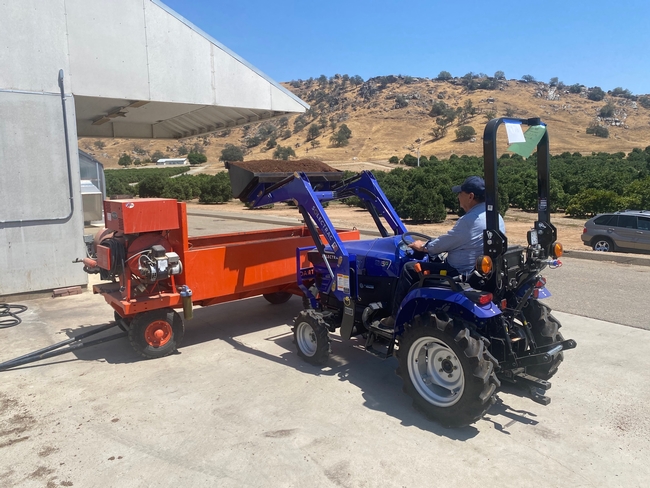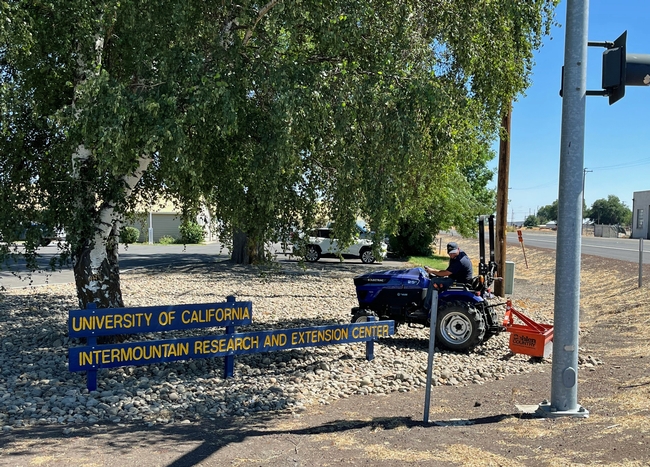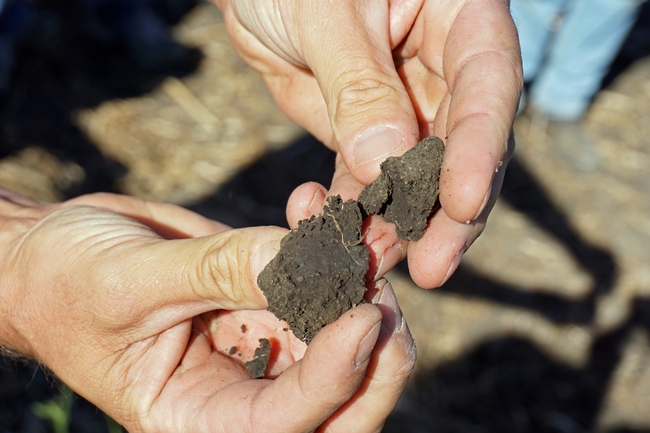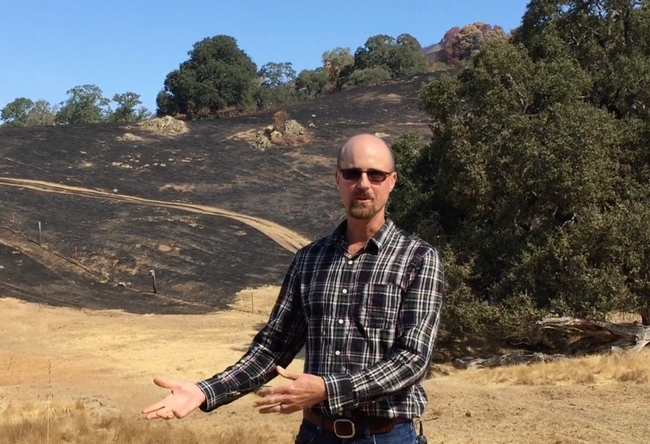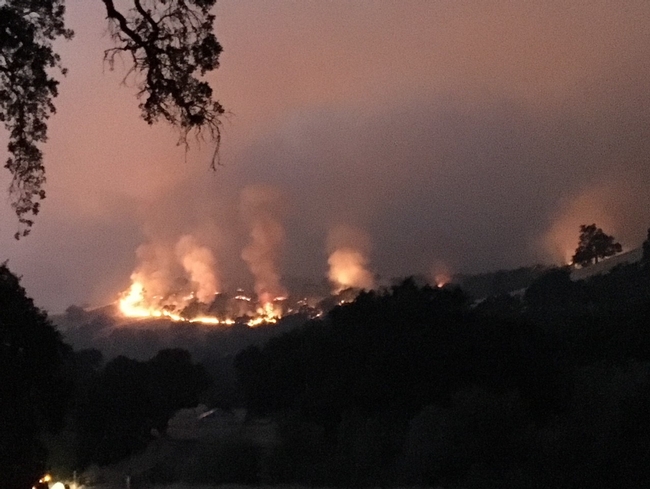
Posts Tagged: John Bailey
Electric tractors reduce carbon emissions at UC ANR research and extension centers
Zero-emission tractors perform many tasks of diesel tractors, without noise or exhaust
The University of California, a national leader in sustainability, has pledged to become carbon neutral by 2025. To reduce its reliance on fossil fuels, UC Agriculture and Natural Resources has replaced several of its diesel-powered tractors with electric tractors at its research and extension centers.
Seven of the nine UC research and extension centers – Intermountain located in Siskiyou County, Hopland in Mendocino County, Kearney and West Side in Fresno County, Lindcove in Tulare County, Desert in Imperial County and Hansen in Ventura County – started using the Solectrac e25 in July. The researchers plan to share what they learn from using the electric tractors.
“Charging is easy, we are using a standard 110V connection, no charging station needed,” said John Bailey, director of the University of California Hopland Research and Extension Center. “For faster charging, you can use a 220V connection – again, no charging station needed, just a regular receptacle – but we haven't gone there yet.”
The electric tractor runs for about five hours, depending on the type of use and the speed, on a charge.
“We will use the electric tractor to mix the soil for planting trees in the greenhouse,” said Ashraf El-kereamy, director of UC Lindcove Research and Extension Center in Exeter, which focuses on citrus research. “Also, for pulling the trailer with the fruit bins during harvest, it will be good as it does not emit any gases.”
The electric tractor is being used to move materials in the loader at UC Hopland REC. “It has worked well for this, functioning similarly to a standard diesel tractor,” said Bailey.
“We have also used it to clean our sheep barn, scraping the pens to get ready for lambing season,” Bailey said. “This involves pushing or dragging straw bedding and manure. The tractor functions well in tight spaces due to its compact size.”
Bailey learned one downside is that the front end is a little too light, making it difficult to generate enough downward pressure with the loader to effectively scrape the floor without reducing the front wheel traction.
“We are planning to add some weight to the front, a standard practice with tractors to increase traction. The tractor has the mounting to enable this so it should not be a big deal,” Bailey said. “Our operators really appreciate the lack of noise and exhaust, especially when working in the barn or in tight spaces.”
The small electric tractor is also being used in tight places at the UC Intermountain Research and Extension Center in Tulelake.
“The tractor that we obtained from the company is too small for the majority of our farm needs,” said Rob Wilson, Intermountain REC director. “We purchased a small box scraper and rototiller for the tractor and we are using it around our facility grounds. We also use it out in the field in tight spaces that are too small for our larger tractors to operate.”
“The tractor is quiet, powerful for its size and operates very similar to the diesel-powered tractors with regard to the controls, hydraulics and three-point assembly. The tractor also has a lot of torque and speed.”
Annemiek Schilder, director of UC Hansen Agricultural REC, added, “I think another advantage is that the tractors can go very slowly, which is helpful for some uses such as harvesting.”
The researchers will continue to evaluate the electric tractors throughout the year.
“Our main usage will come in the spring, mowing around our headquarters and on roadsides,” Bailey said. “We are purchasing a 4-foot flail mower that can mount to the rear PTO, but won't really put it into use until April.” The power take-off, or PTO, is the shaft that transfers power from the tractor to the attachment.
Other benefits of electric tractors include no engine oil to change and no diesel fuel.
“If the farmer already has solar, they will see close to zero fuel charges,” Bailey added. “Even without solar, their fuel costs should be reduced depending on local electrical cost. Also, the engine only has one moving part compared to dozens in a diesel tractor so maintenance costs should be reduced significantly, something that is proving true in electric cars.”
The Solectrac e25 tractors each cost $27,999 and the optional loader was about $4,000.
The California Air Resources Board is offering incentives to buy zero-emission equipment through its Funding Agricultural Replacement Measures for Emission Reductions Program. FARMER provides funding through local air districts for agricultural harvesting equipment, heavy-duty trucks, agricultural pump engines, tractors and other equipment used in agricultural operations.
UC Cooperative Extension to investigate healthy soil practices with CDFA grants
Six UC Cooperative Extension research projects were awarded funding ranging from $100,000 to $250,000 each from the California Department of Food and Agriculture Healthy Soils Program. The grants are designed to fund implementation and demonstration of on-farm soil health practices that reduce greenhouse gas emissions and store carbon.
One of the grant recipients, John Bailey, director of the UC Hopland Research and Extension Center in Mendocino County, will use the $100,000 award to establish a perennial hedgerow at the center. Hedgerows are not traditionally part of standard ranching practices in Mendocino County, where in the past the center's 5,400 acres of rangeland and surrounding areas were grazed by large flocks of sheep.
“At Hopland, we have pivoted our operation to reflect the current state of the sheep industry in California, with reduced overall sheep numbers and decreased individual flock size, so we will use this project to show our smaller-scale sheep owners how they can enhance the ecosystems of their properties,” Bailey said.
Bailey expects the hedgerow to offer many educational, ecological and practical benefits, including enhancing soil health, increasing soil carbon sequestration, and providing habitat and food sources for beneficial organisms, such as pollinators and birds.
There may also be economic benefits to using sustainable practices in raising sheep. The project will explore the financial costs of implementing hedgerows as well as the opportunity for producers to enter a niche fiber market by offering sustainably produced wool to textile companies and consumers willing to pay a premium to support the ecological benefits of Healthy Soil Projects.
“I'm excited about this opportunity to combine the latest knowledge on environmental sustainability practices with the older traditions of livestock grazing in Northern California,” Bailey said. “This is a progressive step that ties in ecological knowledge that can benefit the livestock ranching model by both enhancing their properties and creating new markets for their products.”
The following projects were also funded by CDFA Healthy Soils Program in 2020:
Integrated sustainable nitrogen management in vegetable cropping systems, $250,000
Maria de la Fuente, UCCE county director and advisor, Monterey and Santa Cruz counties
The implementation of climate-smart agricultural practices within intensively managed vegetable cropping systems is extraordinarily challenging. Often conservation practices cannot be effectively implemented due to operational barriers, resulting in very low rates of adoption.
By demonstrating nutrient management strategies in partnership with a large influential vegetable grower in the Salinas Valley, the project aims to encourage broad scale practice adoption.
Recent research has indicated the addition of organic amendments in combination with nitrogen fertilizers potentially reduces nitrogen-derived greenhouse gas emissions and nitrate leaching while increasing soil carbon stocks. These outcomes will generate significant climate benefits in agroecosystems experiencing heavy tillage and fertilizer inputs.
This project has the potential for statewide impact as the researchers are currently working with the developers of COMET-Farm to provide data and coordinate outreach within vegetable cropping systems. Through direct engagement the team will make integrated sustainable nitrogen management more feasible and agronomically favorable for producers.
Using hands-on COMET-Farm-focused field days and a webcasted sustainable nitrogen short course, the project will provide producers with additional tools to make nutrient management planning decisions that have positive climate and soil health outcomes.
Evaluation of compost application to processing tomato fields in the Sacramento Valley, $100,000
Amber Vinchesi-Vahl, UCCE vegetable crops advisor, Colusa, Sutter and Yuba counties
The project will demonstrate compost applications on two farms in two Sacramento Valley counties, Colusa and Sutter. The researchers will work with Westside Spreading LLC and compare two plant-based compost rates to a control (no compost) over three years. Soil health parameters – such as total carbon and nitrogen, pH, EC, organic matter and fertility analyses relevant to tomato crop production – will be measured.
The benefits of compost applications vary depending on how often they are used, how much is applied, crop rotation, and other management decisions, such as whether compost is incorporated or left on the soil surface. Vinchesi-Vahl expects that over time the compost implementation evaluated in this project will result in lower input costs and improved soil function.
Compost application may reduce the need for fertilizer inputs for some of the rotational crops and provide benefits to the microbial community, thereby improving soil structure and reducing heavy conventional tillage needs.
By improving soil health, the research expects plant health will also be improved, leading to better tolerance to pest pressure from diseases and weed competition.
The two demonstration sites will showcase compost applications and their impact on processing tomato production and annual production soil health. These focused demonstrations will be extremely important in showcasing this soil health practice in the local Sacramento Valley region, providing information to growers from the experiences of collaborators at the two sites.
Evaluation of winter cover crop species for their ability to mitigate soil compaction in an annual rotation, $100,000
Sara Light, UCCE agronomy advisor, Sutter, Yuba and Colusa counties
This project has three components:
- Replicated research plots in which three cover crop varieties are evaluated for improvements in soil structure, specifically subsurface soil compaction
- Fieldscale demonstration plots in which varieties thought to reduce soil compaction are planted and visually assessed for performance in the Sacramento Valley
- Small, single-row hand planted plots in the buffer area, in which a wider number of both summer and winter cover crop varieties will be planted for outreach and demonstration purposes
Combined, these components will enable growers to make more informed decisions about cover crop selection and encourage wider adoption of cover cropping. The outreach objective for this project is to reduce barriers to cover crop adaption among regional growers by increasing knowledge and information about varietal selection and field-scale cover crop management, as well as opportunities to improve soil structure using cover crops.
Healthy soils demonstration project with Cardoza Farm, $100,000
Ruth Dahlquist-Willard, UCCE small farms advisor, Fresno and Tulare counties
This project will demonstrate compost application, hedgerow planting, and application of mulch generated from cover crop residue in a vineyard producing organic raisin grapes. Mulch will be applied directly under the vines, providing ground cover that will conserve soil moisture and decrease weed pressure. Generating the mulch on-farm eliminates the need to transport materials from outside sources.
Currently, production of organic raisin grapes involves frequent tillage under the vines. The cover crop between rows and the mulch under the vines will reduce the need for tillage for weed control and increase soil organic matter. These practices will be showcased at field days that will include bilingual training for small-scale, socially disadvantaged farmers in the San Joaquin Valley.
Application of compost to alfalfa to improve soil structure and fertility, $250,000
Kate Scow and Radomir Schmidt, UC Davis Department Land, Air, Water Resources and UCCE advisors Michelle Leinfelder-Miles and Rachael Long
This project will demonstrate compost application to alfalfa for improving soil structure and fertility. Compost is not typically applied to alfalfa; however, manure application to alfalfa is common in the state's dairy regions.
The over half a million acres of alfalfa in California could represent an important repository for compost, for which a large land base of spreading may be needed as municipalities convert organic waste management streams to diversion from landfills.
Alfalfa has the ability to immobilize large amounts of nitrogen and phosphorus, nutrients of concern in the concentration of organic wastes due to their potential to contribute to water pollution. Furthermore, alfalfa growers are interested in the potential of compost to improve soil structure in their alfalfa fields, as many growers report suffering from the large cracks that form in soils during the wet-dry cycles of alfalfa surface irrigation management.
Compost application has been anecdotally reported to alleviate soil cracking in another perennial crop, almond orchards in the Central Valley, but soil structure improvement via management practices like compost application has received little research attention thus far. Westside Spreading LLC is collaborating on this project.
Bailey appointed to USDA Advisory Committee on Beginning Farmers and Ranchers
John Bailey, director of the University of California's Hopland Research and Extension Center, has been appointed to the U.S. Department of Agriculture's Advisory Committee on Beginning Farmers and Ranchers by USDA Secretary Sonny Perdue. Bailey's two-year term expires on Sept. 17, 2021.
The purpose of the Committee is to advise the USDA Secretary on strategies, policies and programs that enhance opportunities for new farmers and ranchers.
“As a member of the Committee, you will advise me on matters impacting beginning farmers and ranchers, including access to land and capital, recruitment and retention of farmers and ranchers, and more,” Perdue wrote in Bailey's appointment letter. “Your role is vital as I strive to obtain the public and industry perspectives on National and State strategies, policies, and programs impacting beginning farmers and ranchers.”

Before joining UC Agriculture and Natural Resources, Bailey was the Mendo-Lake Food Hub project manager for North Coast Opportunities, where he developed a regional food hub with an integrated training, marketing and distribution system that allowed regional specialty crop growers to dramatically increase sales of their crops.
Prior to that, Bailey worked at McEvoy of Marin for 12 years. He started in horticultural operations in McEvoy's vegetable gardens and fruit and olive orchards and worked his way up to director of operations, overseeing product development, production and distribution of their botanical-based body care brand as well as national sales and marketing for their private label soap line. He also owned and operated Middle Mountain Farm, which grew and marketed specialty crops to retail and wholesale customers. He is currently a partner in a bulk wine storage company in addition to overseeing Hopland Research and Extension Center's 5,300 acres of oak woodland, grassland, chaparral and riparian environments for research and education.
“In my various roles related to, and diverse network of professionals contacts in, agriculture, combined with my experience in multiple business enterprises, I have gained experiences and knowledge which will help me provide solid advice to the Secretary,” said Bailey. “I am honored to be appointed to this committee and will do my best to advise the Secretary on issues affecting beginning farmers and ranchers across our state, and methods that show promise for assisting them in their agricultural careers.”
The Advisory Committee on Beginning Farmers and Ranchers is made up of 20 members from organizations with demonstrated experience in training beginning farmers and ranchers, and other entities or persons providing lending or technical assistance for qualified beginning farmers and ranchers. Congress authorized the committee in 1992 and since its inception, the advisory committee has been an important part of the USDA strategy to engage, support and serve new and beginning farmers. The committee is funded by the Farm Service Agency. USDA's Office of Partnerships and Public Engagement provides oversight, which ensures fiscal accountability and program integrity.
Californians must adapt their lives to fire
California is a place forged by fire, and its fierce fire-fighting policies are creating fuel-filled landscapes that will burn hotter and faster than ever, reported Lisa M. Krieger in the San Jose Mercury News.
"Unless we change course, we'll never work our way out of this dilemma," said UC fire scientist Scott Stephens. "Unless we can get ahead of it, it'll never get better."
Strategies to live with fire were modeled at the UC Hopland Research and Extension Center when the Mendocino Complex Fire spread on its rolling oak woodland and chaparral landscape in late July. About 3,000 of the center's 5,300 acres burned.
In pastures where sheep had grazed, the oaks still have green leaves. In other areas not grazed since the 1950s, undergrowth provided a ladder for flames to reach oak canopies.
In areas were vegetation was reduced by grazing, "the fire was less intense. It skipped around more. It wasn't as complete a burn," said Hopland director John Bailey. "Having animals on the land reduced the hazard."
(Read more about the fire at Hopland in a blog post by community educator Hannah Bird.)
Prescribed burning is another strategy to maintain a forest that is resilient to fire.
“Prescribed burns are a really powerful and underused tool,” said UC Davis ecologist Malcolm North. When a wildfire hits pre-burned areas, “it just putzes along.”

